F1 2020: can performance boosts deliver 60fps on all consoles?
Codemasters' best Formula 1 game yet.
The Formula 1 series has gone from strength to strength with each year. From the work developer Codemasters puts into its sublime HDR and volumetric lights in the most recent instalments to the new team-building career mode of F1 2020, there's always a forward step. What isn't so widely explained about 2020 though is the technical upgrades: to the tracks, the cars and the Ego engine powering it all. The good news is that beyond the graphical changes this time around, performance is unquestionably superior in this year's edition - but does it come with a cost?
At least looking at the base rendering stats, it doesn't appear to be the case. All of the pixel counts of last year are left as-is essentially, though digging into the PC version gives some idea of how the options work on the consoles. Xbox One, for example, is arguably the most fascinating; it's using a 1080p target, but with heavy reconstruction to achieve it. As a result you get checkerboard artefacts on any movement. It's easy to pick out in stills, though in fairness, those artefacts blend nicely with a temporal anti-aliasing pass that cleans it up in motion. The combination of checkerboarding and TAA is a big feature on PC too; a real performance saver if you need it, with dynamic resolution options opening up for it in a greyed sub-menu. It even lets you pick the frame-rate target - 30, 60 and beyond, plus the aggressiveness of the scaling. It's really impressive stuff, and I'd expect these settings are used behind the scenes on the console builds too.
It's a challenge to pinpoint the lowest resolution figure on Xbox One, but for context, PC lets you drop it to 50 per cent scale of the target. That's an extreme measure, but would give the engine flexibility to adjust for 19 AI cars, heavy rain and complex tracks like Monaco. What's also clear is that base Xbox One relies heavily on this reconstruction - more so than any other version - whereas the other consoles barely show the same artefacts, including the base PS4. Sony's machine pushes a 1080p target just like last year, but with far less visible noise around edges on motion, suggesting it hits 1080p natively more often. Otherwise Xbox One X is again a 3840x2160 target image with potentially a minimal use of reconstruction to get there. PS4 Pro is very similar to the X rendition, though the max resolution sits at 3200x1800.
The resolution setup stays much the same as the 2019 edition but what's most curious is the visual tweaks. There are optimisations made all round, even extending to the PC edition. Taking the detail-rich Monaco circuit as an example, trees are completely redesigned, looking somewhat less complex - even on Xbox One X and PC at max settings. On the base Xbox, LOD tweaks are evident to buildings in the far distance, while curiously, the screen-space reflection model is updated and actually improved. On the other circuits, the assets are less widely updated, but still touched upon. Foliage changes are in place - bizarrely, the intensity of volumetric lights is dialled back a little for night racing, just in terms of brightness. The result is a game that largely retains the look of its predecessors, but with clear optimisations under the hood to improve the way it scales to less powerful machines. Thankfully this isn't a drop in AI cars to suit the CPU limits of those base consoles - the changes are subtle, purely visual, but do have an impact on performance.
There's closer look at the knock-on to frame-rate in the embedded video above but the bottom line is that the F1 series is dynamic in terms of visible cars, circuit complexity and weather conditions - and that could cause problems as the potential rendering challenges stack up. Even on a 'lighter' track, adding heavy rain into the mix could see Xbox One and even PS4 Pro struggling to hit the target 60fps, the end result being visible stutter and tearing.
Codemasters' optimisation push goes a long way in addressing this in F1 2020 and while the read-out isn't completely solid (there are still some dips into the high 50s), it's a clear and noticeable improvement. Tearing is less abundant and as far as the base consoles go, it's great to see Codemasters put the time into fine-tuning the engine. It's not a uniform upgrade across the game, and the starting grid is still a trouble spot, but it's noticeably better.


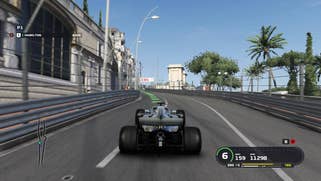
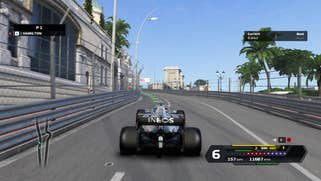



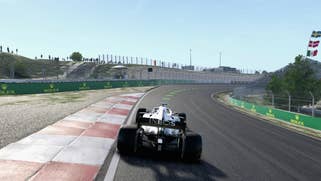
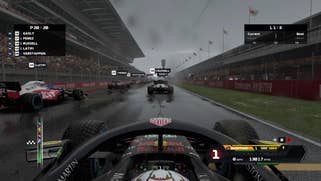
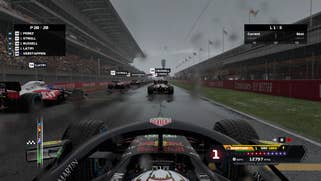


Looking at the base consoles, PS4 still delivers a cleaner image and more sustained performance, but the gap has narrowed and the Xbox One version is still a great game to play. It's all positive for the base machines, whereas the enhanced consoles generally stay as they were in the frame-rate stakes. 60fps was easily achieved on both PS4 Pro and Xbox One X last year - with a few exceptions on Pro involving the heavy rain setting. Looking at these points in F1 2020, there's barely a single drop under that number now. In cases where it does, the screen-tearing kicks in to avoid noticeable stutter. All round, these two versions were the least in need of improvement, though it's curious to see that the tweaked foliage of the base machines is kept. For the most watertight experience I'd still back Xbox One X for its avoidance of any drops in the face of too many cars on-screen, but you can't really go wrong with either.
There are plenty of other benefits to playing on Pro or X. A direct comparison between Xbox One consoles bears this out as we look at the extreme ends of the current-gen console power ladder. You'll enjoy higher resolution textures on par with PC's top preset. There's better draw distance on shadows, plus road markings - which makes sense given the higher resolution window. On top of that there's fuller plantlife on the roadsides of tracks like Zandvoort - a small embellishment that bulks them out with more leaves. All of this tends to just whip by during a race. It's only during intro fly-bys that any of these details hold muster. Bizarrely, shadows do appear more diffused on Xbox One X - softer, at least at range. Still the biggest divide during a race remains the resolution side; a 1080p picture achieved through checkerboarding on left, versus a 4K target on right. As you might expect, PS4 Pro is essentially identical to Xbox One X in terms of features - it's just moves its target to 1800p instead.
The technical evolution of the F1 series is a steady one but it shows that Codemasters is still committed to giving current-gen machines a priority and the series is now better-performing than ever before, which some might say is the most important part of any racing package. There's no sign just yet of where the team intends to go for the series' transition to next-gen consoles. Will Codemasters aim for a 120fps performance mode as the firm has promised for Dirt 5? Will we see 4K at 60fps with ray tracing, as revealed in Gran Turismo 7 on PlayStation 5? It would be great to see similar strides from Codemasters, but in the here and now, as a swansong of sorts for the current generation, F1 2020 sees the studio deliver the best iteration of the game yet.



